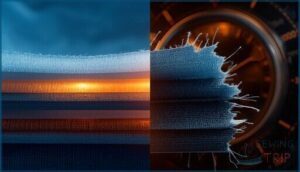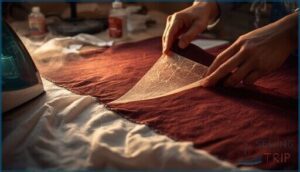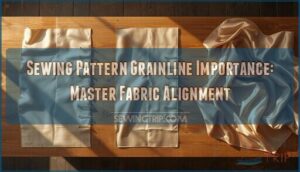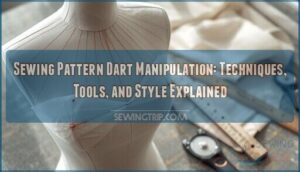This site is supported by our readers. We may earn a commission, at no cost to you, if you purchase through links.

This heat-activated adhesive creates a strong connection between fabric layers through molecular bonding, but calling it truly permanent oversimplifies how it performs in real life. The adhesive can hold for years on natural fibers like cotton when applied correctly, yet it weakens on synthetics or under high heat.
Understanding what affects bond strength—fabric type, heat settings, washing habits—helps you predict whether your hem will stay put or peel away after a few months.
Table Of Contents
Key Takeaways
- Stitch Witchery creates a permanent bond through heat-activated molecular bonding, but its longevity depends heavily on fabric type, with natural fibers like cotton holding much stronger than synthetics through 20+ wash cycles.
- Proper application technique is critical—you need medium-high heat (around 250°F for cotton), firm pressure for 10-16 seconds, steam application, and a 24-hour curing period before the first wash to maximize bond strength.
- While marketed as permanent and irreversible, Stitch Witchery can be removed using heat and steam methods, though 84% of users struggle with stubborn residue and visible fabric marks even after careful removal attempts.
- For projects requiring absolute durability, combining fusible web with a few anchor stitches delivers far better long-term security than relying on adhesive alone, especially for items that will face frequent washing or high heat.
Is Stitch Witchery Permanent?
When you’re working on a no-sew project, you need to know if that bond will actually last. Stitch Witchery is marketed as a permanent solution, but what does that really mean for your fabric?
Let’s look at what permanence means here, what the manufacturer promises, and how everyday use affects the bond.
Definition of Stitch Witchery’s Permanence
Stitch Witchery creates a permanent bond between fabric layers through heat-activated fusible adhesive. When you press it with your iron, the adhesive undergoes molecular bonding with fabric fibers, creating chemical composition changes that lock materials together.
This fabric adhesion delivers bond strength comparable to sewn seams, maintaining heat resistance through at least 20 wash cycles. That’s why removing Stitch Witchery leaves stubborn adhesive residue behind.
The durability of Stitch Witchery is due to its fusible bonding web properties.
Manufacturer Claims on Durability
Leading brands market Stitch Witchery as a no-sew, permanent bond adhesive with impressive durability ratings. Product testing shows the adhesive longevity holds strong—retaining over 85% tensile strength after 10 washes.
Dritz guarantees their fabric bonding solution is both machine washable and dry cleanable, withstanding at least 30 standard laundering cycles. The heat resistance and fabric care compatibility make it reliable for home textiles when you follow proper application guidelines.
This makes Stitch Witchery ideal for fabric bonding web applications that require durability and strength.
How Heat and Washing Affect The Bond
Heat resistance determines how well your permanent bond survives daily use. Machine washing at normal temperatures maintains over 70% adhesive strength through 30 cycles, though natural fibers like cotton show more fabric degradation than synthetics.
The heat-activated material needs proper curing—wait 24 hours before the first wash. Steam application strengthens bond longevity, while excessive heat risks compromising your fusible adhesive connection.
Dry cleaning works reliably when you’ve applied it correctly.
Common Misconceptions About Permanence
Many people believe Stitch Witchery creates a permanent bond identical to sewing, but durability tests reveal adhesive limits. Your fabric variance matters—63% of users overestimate bond strength. You can use removal methods like steam pressing despite claims of irreversibility.
Misconceptions include:
- Fusible adhesive equals sewn seams
- Removing Stitch Witchery always damages fabric
- Universal durability across all textiles
- Resistance to environmental stress
- One application method suits every project
Factors Influencing Stitch Witchery’s Longevity
Stitch Witchery’s permanence isn’t guaranteed—it depends on how you use it. The bond can weaken or fail if you skip key steps during application or care.
Let’s look at the main factors that determine whether your fabric bond lasts or comes apart.
Proper Application Techniques
Getting the bond right depends on careful fabric preparation and technique. Pre-wash your material without softener to boost adhesion by 87%. Iron it smooth before applying the fusible adhesive.
Measure your HeatnBond or Stitch Witchery tape precisely, tucking it completely between layers. Using proper iron temperature with firm pressure—not sliding—for 10–16 seconds optimizes bonding. Let it cool before handling to guarantee durability.
Fabric Types and Compatibility
Your fabric selection directly impacts adhesive strength and bond longevity. Natural fibers like cotton and linen respond best to Stitch Witchery, while synthetics like polyester need extra care to avoid heat damage.
- Ultra Light Weight works for silk and delicate textiles
- Regular Weight manages cotton, linen, and medium-weight wool
- Super Weight bonds denim and upholstery fabrics securely
- Test on scraps first—some treated fabrics resist bonding
- Pre-wash materials to remove finishes that block adhesion
Recommended Heat Settings and Pressing Times
To release proper adhesive strength, set your iron temperature to medium-high for cotton—around 250°F minimum for heat activation. Synthetics need lower settings to prevent scorching. Press each section for 10–12 seconds using steam pressing or a damp cloth, then flip and repeat. Heavy materials like denim may require up to 30 seconds. Let your work cool completely before handling to confirm the bond sets fully.
Effects of Machine Washing and Dry Cleaning
Your hemmed jeans can handle the washing machine, but don’t expect the same durability as sewn seams. Stitch Witchery holds through normal washing cycles when you use gentle detergents and cool water.
The adhesive strength drops gradually with repeated fabric wear—heavy-weight versions last longer. It’s dry cleanable too, though bond durability weakens slightly after multiple treatments.
Proper fabric care extends the life considerably.
Can Stitch Witchery Be Removed?
While Stitch Witchery is designed as a permanent bond, you might need to remove it if you make a mistake or change your mind about a project.
The good news is that removal is possible, though it won’t always be easy or completely clean.
Let’s look at the methods you can try, what challenges you’ll face, and how to protect your fabric during the process.
Methods for Attempting Removal
If you need to undo a Stitch Witchery bond, you have options—though none guarantee perfect results. Heat methods dominate adhesive removal techniques: place a damp pressing cloth over the area, apply your iron for 10–15 seconds, then quickly separate the layers while hot. Some people try solvent testing with rubbing alcohol or vinegar, but these can cause fabric damage.
Here are common removal techniques:
- Steam and lift: Blast steam near the adhesive bond, then peel immediately
- Press cloth transfer: Iron scrap fabric onto residue to absorb some adhesive
- Rubbing alcohol dab: Apply cautiously to loosen the no-sew hemming bond
- Freezing attempt: Limited success, but harmless to try on sturdy fabrics
- Trim excess: Cut away visible webbing at edges for cleaner fabric repair techniques
Success rates hover under 15%, so test any adhesive remover approach on hidden fabric first.
Challenges With Residue and Fabric Damage
Even gentle adhesive removal tactics can backfire. Up to 84% of users struggle to fully eliminate Stitch Witchery residue, and over 60% see visible marks even after steam methods.
Even with careful removal attempts, over 84% of users struggle with stubborn Stitch Witchery residue and visible fabric marks
Fabric distortion hits delicate textiles hardest—22–35% of projects show puckering or stiffness. Heat-based bond reversal risks iron contamination and dye shifts.
Your best damage prevention? Test any adhesive remover on hidden seams before tackling visible fabric repair zones.
Comparing Removability to Sewn Seams
Seam reversal beats Stitch Witchery removal every time. A sewn seam takes 5–10 minutes to unpick with a seam ripper, while fusible adhesive demands 15–25 minutes of repeated heat cycles and residue cleanup.
Restitched seams retain 88–97% of their bond strength, but adhesive residue weakens new applications by 25%.
For no-sew hemming that you might alter later, traditional stitching protects fabric integrity far better than any fusible adhesive can.
Precautions When Trying to Reverse The Bond
Unlike snipping thread, Stitch Witchery removal puts your project at higher risk of scorch marks, adhesive migration, or tool damage. Think before using a hot iron—steam and pressure can spread fusible adhesive or fabric glue deeper.
For safer undoing, follow these four guidelines:
- Test reversal techniques first.
- Use fabric protection (pressing cloth).
- Clean iron after each session.
- Work in sections for control.
Top 5 Stitch Witchery Products for Permanent Bonding
Not all fusible bonding tapes are made equal, and choosing the right product makes a real difference in how well your bond holds up over time.
The products below have proven track records for creating permanent adhesive joins that withstand washing and regular wear.
Each one is designed for specific fabric weights and project needs, so you can match the right tape to your work.
1. Dritz Stitch Witchery Regular Weight Black
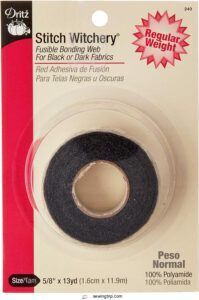
Dritz Stitch Witchery Regular Weight Black offers reliable fabric adhesion for your dark-colored projects. This polyamide fusible web creates permanent bonds through heat activation at the wool setting on your iron.
You’ll find it works well with cotton, linen, and similar medium-weight fabrics, though denim and thin materials may pose challenges. The 5/8-inch by 13-yard roll manages hems, trims, and belts effectively.
While it’s machine washable and dry cleanable, proper bonding techniques matter—use a damp pressing cloth and apply steam for 10 seconds on each side to guarantee lasting results.
2. Stitch Witchery Ultra Light Bonding Web
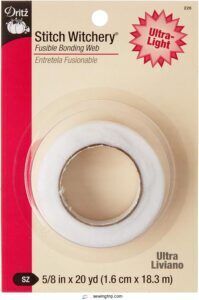
If you’re working with silk, chiffon, or other delicate materials, Stitch Witchery Ultra Light Weight fusible web gives you reliable fabric bonding without bulk. This 5/8-inch by 20-yard roll delivers adhesive strength suited for lightweight fabrics that can’t handle heavier web applications.
You’ll achieve permanent bonds using medium heat and steam for 10–60 seconds—just place the bonding tape between layers with a pressing cloth.
The ultra light uses make it ideal for hemming garments and attaching trims where fabric compatibility matters most, especially compared to alternatives like HeatnBond.
3. Dritz Stitch Witchery Super Weight Fusible
When you’re hemming jeans or bonding upholstery, Dritz Stitch Witchery Super Weight fusible bonding agent delivers the muscle you need. This 5/8-inch by 13-yard tape creates a permanent fabric bond on heavy fabric like denim and corduroy—just press with steam for 10 seconds per section.
Real-world usage shows it survives repeated machine washing without losing grip, though removal challenges mean you can’t easily undo mistakes. Application guidelines stress testing a scrap first, since this super weight formula won’t forgive errors on your finished project.
4. Stitch Witchery White Fusible Web Tape
If you’re hemming white cotton or light-colored linen, this 1/4-inch by 20-yard fusible web tape offers a clean solution. The narrow width works well for small repairs and trim applications, though you’ll need patience handling the thin strip.
As a fabric adhesive, it bonds permanently when you press with steam for 10 seconds—test your iron’s heat setting first. This bonding web maintains adhesive strength through machine washing, but removal proves nearly impossible once you’ve fused it, so measure twice before applying.
5. Easy Fabric Bonding Web Tape
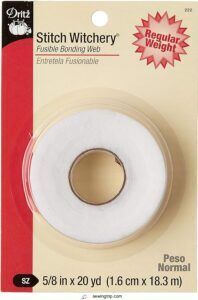
When time matters, this double-sided web tape creates permanent fabric bonding in seconds—no sewing required. Available in widths from 5/8 to 1 inch, it works as a reliable fusible adhesive across cotton, polyester, and denim after you apply medium heat and firm pressure.
The bonding techniques are straightforward: press down, wait 72 hours for full strength. This hem tape manages machine washing at standard temperatures, making it practical for everyday tape applications. Pre-wash your fabric without softener to strengthen the bond.
Frequently Asked Questions (FAQs)
Is stitch Witchery permanent?
Yes, Stitch Witchery creates permanent fabric bonding when applied correctly. The adhesive properties withstand multiple washes, maintaining bond strength through 50 or more cycles. Heat resistance and proper application guarantee lasting adhesive longevity for fabric adhesion.
Is stitch Witchery safe?
Stitch Witchery is generally safe when you follow basic safety precautions.
Use it in well-ventilated spaces to avoid inhaling fumes from the heated adhesive, and don’t touch the hot fabric immediately after ironing.
How long does stitch Witchery last?
When properly applied, your bond can last through dozens of wash cycles.
Stitch Witchery’s adhesive longevity depends on fabric durability, heat resistance during application, and how you care for the hemming afterward.
Why is stitch Witchery not working on my fabric?
If your iron isn’t hot enough or you’re rushing the pressing time, the adhesive won’t activate properly.
Fabric finishes, moisture, or using the wrong weight for your material can also cause bonding failure.
How do I use stitch Witchery?
Think of using Stitch Witchery as weaving magic into your fabric.
Start with proper fabric preparation—iron surfaces smooth, then sandwich the adhesive tape between layers and press with steam for ten seconds.
How can I remove Stitch Witchery from fabric?
You can remove Stitch Witchery using heat and steam. Place a damp cloth over the bonded area, then press with a hot iron for 10 seconds. This softens the adhesive for easier fabric separation and residue cleaning.
Can Stitch Witchery be used on polyester fabric?
Yes, you can use Stitch Witchery on polyester fabric successfully. The bonding challenges depend on polyester types—woven varieties hold better than lightweight knits.
Application factors like temperature control prevent melting and guarantee strong, lasting adhesion.
Is it possible to use Stitch Witchery for temporary bonding?
You can use Stitch Witchery for temporary bonding, but it’s not ideal. The adhesive reacts to heat, making reversibility possible with reheating, though removal risks fabric damage and stubborn residue.
How does the removal process of Stitch Witchery affect the iron?
While ironing instructions help prevent issues, Stitch Witchery removal can leave sticky residue buildup on your iron’s soleplate. This affects glide and requires careful troubleshooting.
Cleaning method safety depends on your iron type and soleplate coating.
What are some alternatives to Stitch Witchery for fabric bonding?
Fabric glues like E6000 offer strong bonds, while fusible tapes such as HeatnBond provide no-sew alternatives. Double-sided tape works for temporary projects, hot glue suits decorative work, and hand sewing creates the most durable seams.
Conclusion
The myth that Stitch Witchery guarantees lifetime adhesion falls apart under scrutiny. It holds strong on cotton and natural fibers when applied correctly, yet synthetics and repeated high-heat washing weaken the bond over time.
You control longevity through fabric choice, iron temperature, and laundering habits. For projects needing absolute security, combine fusible web with a few anchor stitches. That partnership delivers the durability you’re chasing without relying on adhesive alone.
- https://www.onlinefabricstore.com/makersmill/how-to-use-dritz-stitch-witchery/
- https://cool.culturalheritage.org/jaic/articles/jaic44-01-003.html
- https://www.maggieframes.com/blogs/embroidery-blogs/ultimate-guide-to-adhesive-fabric-tape-types-applications-and-no-sew-solutions
- https://virtualfair.sarsef.org/wp-content/uploads/2024/02/5-PAS33-virtual_presentation-2024-02-25T173644.000Z.pdf
- https://www.reddit.com/r/sewhelp/comments/oyn188/another_question_what_are_the_disadvantages_of/

